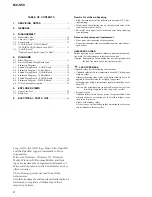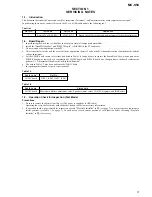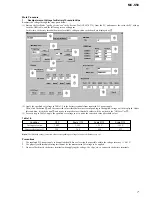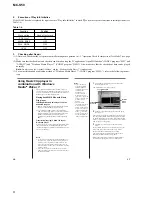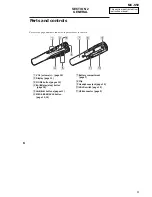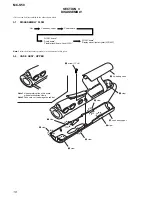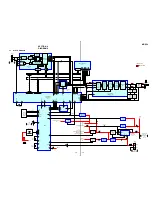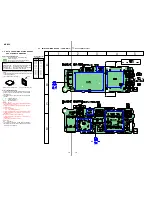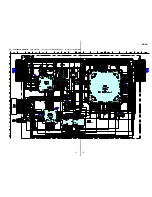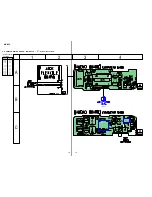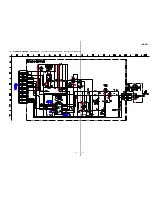
2
MC-S50
TABLE OF CONTENTS
1.
SERVICING NOTES
.................................................. 3
2.
GENERAL
...................................................................... 9
3.
DISASSEMBLY
3-1. Disassembly Flow ............................................................ 10
3-2. Case Assy, Upper ............................................................. 10
3-3. Power Board ..................................................................... 11
3-4. “LOGIC Board”, “AUDIO Board”,
“FLEXIBLE (JACK) Board, Jack (J301)” ...................... 11
3-5. “LOGIC Board”,
“Display Panel, Liquid Crystal (LCD901)” .................... 12
4.
DIAGRAMS
4-1. Block Diagram ................................................................. 13
4-2. Note for Printed Wiring Boards and
Schematic Diagrams ........................................................ 14
4-3. Printed Wiring Board – LOGIC Board – ........................ 14
4-4. Schematic Diagram – LOGIC Board – .......................... 15
4-5. Printed Wiring Board – AUDIO Board – ....................... 16
4-6. Schematic Diagram – AUDIO Board – .......................... 17
4-7. Printed Wiring Board – POWER Board – ...................... 18
4-8. Schematic Diagram – POWER Board – ......................... 19
4-9. IC Pin Function Description ............................................ 22
5.
EXPLODED VIEWS
5-1. Upper Case Assy .............................................................. 26
5-2. Board Assy ....................................................................... 27
6.
ELECTRICAL PARTS LIST
................................ 28
Flexible Circuit Board Repairing
• Keep the temperature of the soldering iron around 270 ˚C dur-
ing repairing.
• Do not touch the soldering iron on the same conductor of the
circuit board (within 3 times).
• Be careful not to apply force on the conductor when soldering
or unsoldering.
Notes on chip component replacement
• Never reuse a disconnected chip component.
• Notice that the minus side of a tantalum capacitor may be dam-
aged by heat.
UNLEADED SOLDER
Boards requiring use of unleaded solder are printed with the lead-
free mark (LF) indicating the solder contains no lead.
(Caution: Some printed circuit boards may not come printed with
the lead free mark due to their particular size)
: LEAD FREE MARK
Unleaded solder has the following characteristics.
• Unleaded solder melts at a temperature about 40 ˚C higher than
ordinary solder.
Ordinary soldering irons can be used but the iron tip has to be
applied to the solder joint for a slightly longer time.
Soldering irons using a temperature regulator should be set to
about 350 ˚C .
Caution: The printed pattern (copper foil) may peel away if the
heated tip is applied for too long, so be careful!
• Strong viscosity
Unleaded solder is more viscous (sticky, less prone to flow) than
ordinary solder so use caution not to let solder bridges occur
such as on IC pins, etc.
• Usable with ordinary solder
It is best to use only unleaded solder but unleaded solder may
also be added to ordinary solder.
Sony, VAIO, the VAIO logo, Music Clip, OpenMG
and the OpenMG logo are trademarks of Sony
Corporation.
Microsoft, Windows, Windows NT, Windows
Media, Windows Millennium Edition and their
logos are trademarks or registered trademarks of
Microsoft Corporation in the United States and/or
other countries.
US and foreign patents licensed from Dolby
Laboratories.
All other trademarks and registered trademarks are
trademarks or registered trademarks of their
respective holders.


